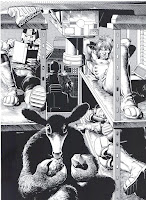 |
| Cover to 2000 A.D. Prog 85 by Mick McMahon. |
 |
| Cover by artist Brian Bolland. |
Last week, I came across an online article that motivated me to pick up a recently published hardcover graphic novel collecting one of Dredd's more popular story lines, The Cursed Earth. Not only does this story arc illustrate the key qualities of its lead character, but it also serves as a legendary historical artifact which, in its entirety, has long been out of circulation. As a result. The Cursed Earth Uncensored, published by 200 A.D., offers insight into what was deemed controversial in the late 1970s, a status achieved here not because of violence, explicit language or sexual content, but due to its potential offense to global corporations.
The stories collected therein are credited to writers Pat Mills, John Wagner and Chris Lowder with art provided by Mick McMahon and Brian Bolland. Bolland also drew the original 2000 A.D. covers, each of which is included in a gallery along with some pin-ups, here deemed "Postergraphs". As shared in the Bleeding Cool article which prompted my purchase: "Published in 2000 AD in 1978, The Cursed Earth ... ran into trouble when two episodes – ‘Burger Wars’ and ‘Soul Food’ – featured parodies of Burger King, Ronald McDonald, the Jolly Green Giant, the Michelin Man, and a number of other prominent corporate characters in a raucous and shameless satire of American consumer culture. After concerns of legal action at the time the then publisher IPC decided collections of this classic strip would omit the satirical stories." Until now.
Suitably, as a "satire of American consumer culture," the story relies on a timeless American literary trope for structure, the road trip. The narrative context of our hero's journey across the radioactive region of America that separates Mega City One and Mega City Two on the West Coast, the eponymous "Cursed Earth", is Dredd's mission to transport an important vaccine from One to the other. Because the original source of the story, 2000 A.D., is an anthology each of the 25 episodic chapters is only 6-8 pages in length. Only the covers and splash pages are colored, resulting a story visually told in black and white.
 |
| Postergraph by Bolland featuring Dredd and two key Cursed Earth secondary characters, Spikes Harvey Rotten and Tweak. |
Suitably, as a "satire of American consumer culture," the story relies on a timeless American literary trope for structure, the road trip. The narrative context of our hero's journey across the radioactive region of America that separates Mega City One and Mega City Two on the West Coast, the eponymous "Cursed Earth", is Dredd's mission to transport an important vaccine from One to the other. Because the original source of the story, 2000 A.D., is an anthology each of the 25 episodic chapters is only 6-8 pages in length. Only the covers and splash pages are colored, resulting a story visually told in black and white.
Among those joining Dredd on his mission of mercy are criminal punk biker Spikes Harvey Rotten and Judge Jack, who are later joined by Tweak, a seemingly unintelligent rock-eater from another planet with a secret. While Dredd is clearly at the center of the story, these three secondary actors each have individual character arcs. The most dynamic of these are the stories of Spikes Harvey Rotton and Tweak, whose fates become intertwined as the crew makes its way across the Cursed Earth.
 |
| From Chapter 11 written by Pat Mills with art by Mike McMahon. |
Even more than the controversial chapters that have been returned to their places in this uncensored edition, this character trait that most subtly satirizes the American culture. While the once "lost" battles between Dredd and Colonel Sanders doppelganger Doctor Gribbons, Ronald MacDonald and the Burger King take overt shots at consumerism, the smaller moments better reinforce the point. The value of The Cursed Earth is perhaps clarified on some level through these stories inclusion, but the power of the satire is not necessarily diminished through their priro exclusion.
Judge Dredd, The Cursed Earth Uncensored is a beautiful hardcover collection with a new introduction by two of the original writers and a gallery of covers and Postergraphs. While not inexpensive at $35 U.S., it is certainly worth the price for those interested in banned books, post-apocalyptic science-fiction or satire. As an introduction to the world of Judge Dredd, this collection is a strong, effective primer.


No comments:
Post a Comment